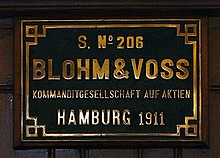serial number

A serial number ( S / N or SN for short ) or factory number , internationally also MSN ( English "Manufacturer Serial Number"), is a unique designation of a product by the manufacturer. The serial number is often alphanumeric with a larger number part. It is used as an identifier for the elements of a series and thus allows tracing back to the production conditions and the components used. It can be part of a product labeling requirement z. B. according to § 6 Paragraph (1) No. 3 in the German law on the provision of products on the market .
In the ISO 8000-2 standard, the term is defined as “a number that is used to identify a single occurrence of a product”.
Classic areas of application
Products are marked with serial numbers in order to clearly identify them and to enable the customer to provide special services or product recalls . For example, it is often only possible to obtain spare parts for technical devices that can be clearly assigned by specifying the serial number. Serial numbers also make it easier to identify stolen goods or forgeries.

Normally, the serial number is attached directly or in the immediate vicinity of the product in order to be associated with the product as quickly as possible. Almost all technical products have a type plate designed in accordance with legal regulations, including a serial number .
Vehicles and machines
Chassis numbers are used in the automotive sector . On bicycles, the frame number used to be stamped on the bottom of the bottom bracket. In the case of large machines and vehicles, including rail vehicles and aircraft (photo), the factory or works number is often part of a representative builder's plate .
Technical Devices
In the case of technical devices, serial numbers are used for guarantee purposes and for quality control, but sometimes also to identify stolen devices.
art
Art prints of works of art, of which the artist has produced a limited number, are usually marked in the form 17/100 . This means that it is the 17th of 100 manufactured objects. The commercial value of the objects decreases with the serial number.
software

With software licenses, serial numbers ( license keys ) are used to reduce black copies . The program can only be used with its full range of functions after entering the required serial number . Since serial numbers can be passed on and, under certain circumstances, generated yourself (e.g. using key generators ), some manufacturers have set up so-called product activation via the Internet, in which the serial number of the software is linked to the identifiers of the hardware on which it is executed. The parallel use of serial numbers is noticeable.
Serials (plural of the short form of English serial number - serial number), often in the Warez- typical spelling serialz , denote illegally distributed or generated serial numbers in the black copier scene .
Luxury goods
Luxury goods, such as handcrafted watches, are marked with numbers so that they can be clearly identified after a theft.
Banknotes
The serial numbers of banknotes are used to record and control the quantity produced, and under certain circumstances also to trace a production lot or a payment (e.g. ransom money ). It consists of letters and digits and, if necessary, one or more check digits to identify reading errors. The serial number is not a security feature for checking the authenticity, since valid serial numbers of issued banknotes are easy to copy and multiple use in the case of counterfeit money can only be determined with great effort.
The serial numbers of euro banknotes have three components: the identification letter of the country of origin (for the ES1 series) or the banknote printer (for the ES2 series), a 10-digit number that is numbered differently depending on the issuing country and a check digit whose calculation method is known (see serial number of the euro notes ).
Banknotes are a mass product and comprise the largest quantity of all individually identifiable products. In the People's Republic of China , more than 20 billion pieces of the 100 yuan banknote are printed annually and differentiated by individual serial numbers. The combination of two letters and eight digits allows 62 billion different serial numbers, the number of which can be expanded almost at will by replacing digits with letters.
ID cards
Almost every ID card is issued with serial numbers; however, these can contain several numbers: form number and individual number. For example, German driving licenses contain both: A list number with reference to the holder and a form number with reference to the form.
weapons
All legally manufactured firearms have a stamped , engraved or lasered serial number for identification on at least one of the main weapon parts (usually the grip, barrel and bolt / drum). In the case of handguns with a polymer grip, numbers or barcodes on cast-in metal plates ( ID tags ) are also common. The serial number is used in Germany e.g. B. noted in the National Arms Register in the arms trade book, in the weapons possession card or in the weapons license.
New areas of application
Recent technical developments make it possible to store serial numbers invisibly in an RFID tag.
Lot number / batch number
With a number of products that are produced in a batch process or batch production , each individual item usually does not have its own serial number, but rather the entire batch or batch has a common batch or batch number.
Web links
Individual evidence
- ↑ ISO Online Browsing Platform, ISO 8000-2, definition 3.13.2. International Organization for Standardization (ISO), accessed April 16, 2020 .
- ↑ Keith Buckle, David Love: British Locomotive Builders' Plates: A Pictorial Guide . Midland Publishing, 1995, ISBN 978-1-85780-018-0 .

